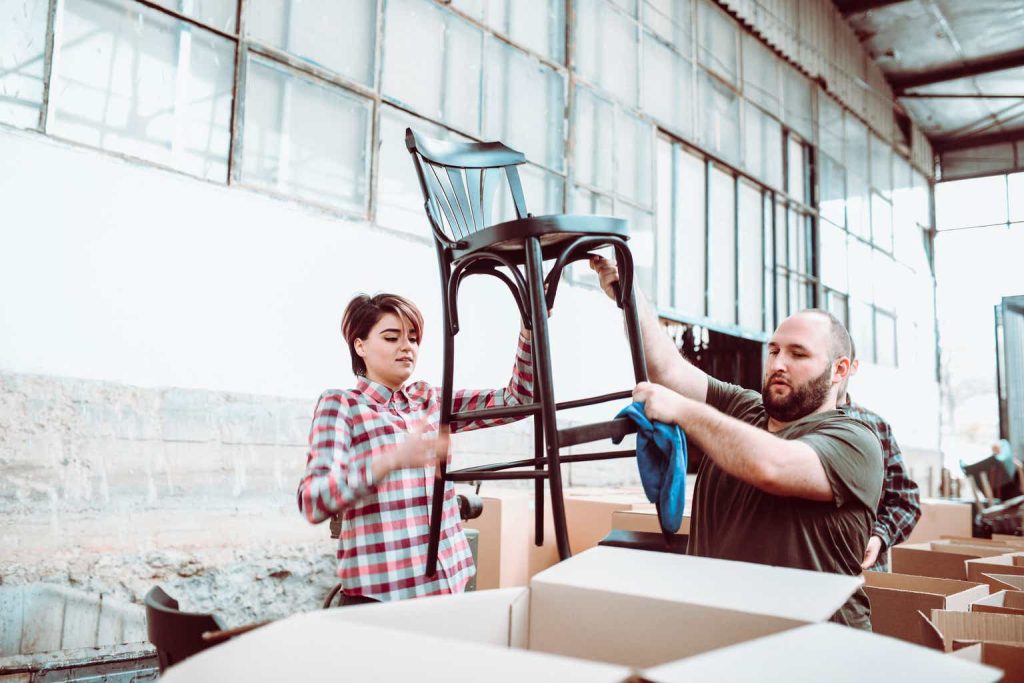Thesis
In June 2023, I initiated coverage of Hooker Furnishings (NASDAQ: NASDAQ:HOFT), examining its risks and potential, noting how it demonstrated some strengths by showing the ability to keep a lid on inventory, recover in its hospitality business, and move forward with expansion plans, along with significant challenges created by a precipitous loss of sales, softening demand, operational inefficiencies, and questions over the safety of the dividend.
The company was undervalued at the time, according to several financial metrics, but elevated debt, declining orders, and questionable dividend sustainability posed substantial risks to the company moving forward, leading me to provide a cautious rating on the stock.
For long-term investors, since my ‘Hold’ call, the stock has a -10% total return compared with S&P500’s 24% gain.
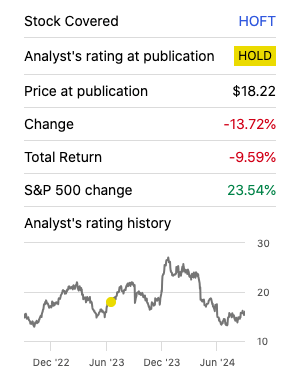
Grassroots Trading ‘Hold’ Call Performance (Seeking Alpha)
Fast-forward to today, Hooker Furnishings’ latest data shows some struggles. The company posted a Q2 2025 GAAP EPS of -$0.19, missing by $0.20.

Seeking Alpha
And $95.08 million in revenue, missing by $4.22 million.
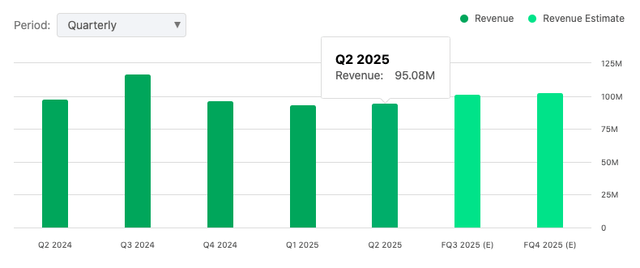
Seeking Alpha
My analysis argues that even with cost cuts and slight revenue gains, Hooker still faces weak demand, operational issues, and cash flow concerns, and its stock price doesn’t match these challenges, resulting in a downgrade to a ‘Sell’ rating.
About Hooker Furnishings
Hooker Furnishings Corporation, started in 1924, is a big name in the furniture world. Based in Martinsville, Virginia, it’s one of the top publicly traded furniture companies in the U.S. They design, make, and import all kinds of furniture—wood, leather, and fabric pieces.
The company runs three main divisions: Hooker Branded, Home Meridian, and Domestic Upholstery. Its products cover bedroom, dining, and home office furniture under the Hooker Furniture brand. They also offer leather and fabric seating through brands like Bradington-Young and Shenandoah Furniture. On top of that, they supply upscale hotels through Samuel Lawrence Hospitality and furnish senior living spaces with H Contract.
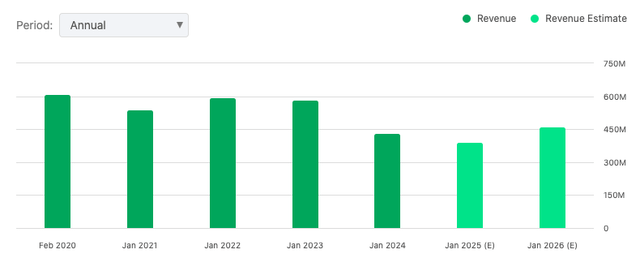
Seeking Alpha
Although they have a strong foothold in North America, selling through retailers, e-commerce, and wholesalers, their annual revenue is projected to decline through 2025 before potentially turning positive again in 2026
Hooker Furnishings’ Performance
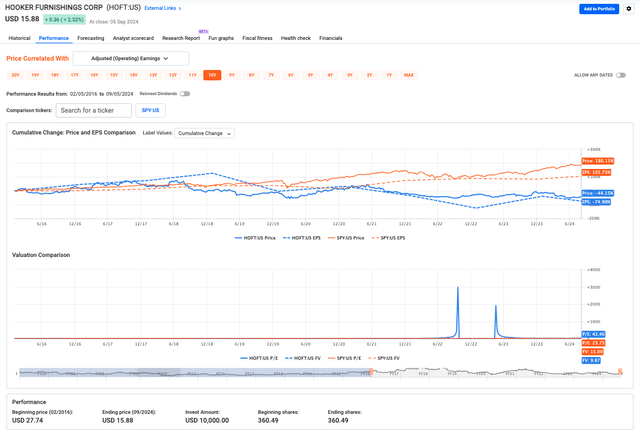
Fast Graphs
HOFT’s stock price has struggled significantly over the last several years—since 2016, the stock dropped from $27.74 to $15.88, which has been rough for long-term investors. This translated to a negative annual return of -6.29%, and when you stack that up against the S&P 500’s solid 13.32% return, it’s clear there’s a big gap. So, including dividends, a $10K hypothetical investment in HOFT decreased to $7.77K, while the same investment in the S&P hit $31.78K.
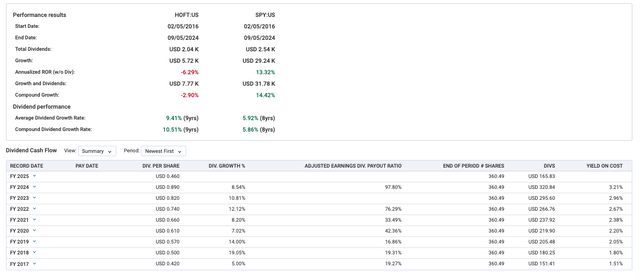
Fast Graphs
Sure, HOFT’s dividend has grown 9.41% annually over nine years, with a compound growth rate of 10.51%, appealing to investors looking for income, especially since the dividend keeps rising even when earnings don’t. The company’s dividend yield and growth rate are good, but that hasn’t made up for the poor stock performance.
But here’s the problem: earnings growth is lacking, and the payout ratio hit 97.80% in 2024, which raises red flags, as it shows that the dividends rely more on cash reserves than actual earnings growth. That, in my view, is not a sustainable path. The 3.21% dividend yield looks good at first, but without stock appreciation and weak total returns, it loses some shine.
Worse still, we see that the negative story is reinforced by Seeking Alpha’s growth grade, which puts them at a D+ – way behind their peers. The decreasing revenues I pointed out earlier manifest here too, down almost 20% year-over-year, while the sector is up 2%.

Seeking Alpha
The outlook isn’t much better: HOFT is set to keep falling by 7.58%, while the sector continues to grow. This tells us the company simply isn’t keeping up with demand and doesn’t seem to have a viable plan to fix it. Their five-year average already looked bad, so this isn’t a new problem.

Seeking Alpha
EBITDA looks worse. A 46.65% drop year-over-year screams poor performance and bad cost control. Other companies are still squeezing out small growth, but HOFT’s massive fall hints at big issues, like rising costs and/or weak pricing power. No forward guidance on EBITDA should tell us if management has any idea how to turn this ship around.

Seeking Alpha
The situation with EBIT is even more dramatic. A 91.95% drop means profits have all but disappeared. This shows the company is failing to keep its costs in check. Shrinking margins and rising costs, likely from inflation or mismanagement, are killing their bottom line.

Seeking Alpha
Lastly, operating cash flow, down 88%, and a 29% drop in working capital make it clear HOFT is struggling with liquidity. They seem to be running low on cash for daily operations, which is a bad omen for any company.
Hooker Furnishings Q2 2025 Earnings Highlights
Still, Hooker Furnishings’ Q2 numbers contained some positives, as sales rose from the prior quarter despite soft market conditions, and it reported $95 million in net sales, down only 2.8% from the same period a year ago—a major improvement compared with the double-digit decline the company posted in the first quarter.
Meanwhile, Hooker Furnishings launched an aggressive fixed-cost reduction plan to reduce fixed costs by 10% and target $10 million in fixed cost savings per year. According to CEO Jeremy Hoff, the company already believes that it will beat this target and expects $5 million in fixed cost savings in each of the next two quarters, which will help stabilize the company’s finances
For example, they’re reducing their Savannah warehouse space by half and combining the BOBO business into the main HOOKER brand by shuttering BOBO’s retail store and warehouse. They’re also offering some employees early retirement and just cut more jobs to save the company $6 million a year. But they’ll have to pay about $3 million in severance in the third quarter of fiscal year 2025.
When asked on the conference call if cutting costs would also reduce spending on maintenance and equipment, CFO Paul Huckfeldt responded that they have postponed some capital expenses (spending on big projects or equipment) to save cash, but they aren’t canceling any projects—just delaying them until the economic situation improves.
Notable here is Home Meridian’s hospitality segment, which delivered a $1.6 million (5.6%) sales lift in Q2, the company’s first quarterly year-over-year growth in two years. Gross margin for Home Meridian (HMI) was 19.5%, one of the company’s best quarters since it was taken over by its parent company in 2016.
They also had a quarterly operating loss of under $1 million, down from the $3.4 million quarterly loss in Q1 and the $3.3 million quarterly loss in the same period last year. Management said that once home furnishings demand normalizes, they see a clear path to profitability.
For the first six months, HMI’s net sales dropped by $13.9 million, or 19%, mainly due to the absence of $11 million in liquidation sales. The remaining decrease was due to lower sales in independent furniture stores and e-commerce, although this was partially offset by growth in the hospitality segment.
When asked about future gross margins, management believes a 20% margin is achievable once the market improves. They attributed the recent improvement not to price increases but to exiting the low-end of the market that had been bringing their margins down.
Meanwhile, Sunset West, with 20% revenue growth in the most recent quarter, is benefiting from the broad pickup—expanding to both coasts is helping address rising demand, especially on the East Coast. The company is also optimistic about a rebound in the housing market. It’s betting on more activity if interest rates soon come down, which would follow recent gains in mortgage refinancing and home sales in July.
Throw in optimism that inflation is slowing – the latest CPI came in at 2.9% – which many think will encourage the Fed to lower interest rates and thereby stimulate demand for housing and furniture.
Hooker Furnishings also reported a stronger financial position, with $42.1 million in cash and plans to pay down $22 million in debt, signaling some much-needed confidence in its stability.
Finally, the company estimates that better than expected Labor Day sales could indicate a return to form in its home furniture business (but that doesn’t necessarily point to a trend going forward). Product improvement and time to market are a priority for the company, with the intention to increase its backlog by the end of the year, particularly targeting the October market.
Hooker Furnishings’ Valuation
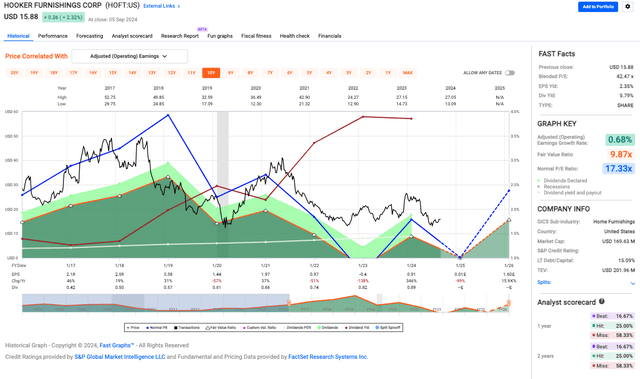
Fast Graphs
HOFT looks overpriced here compared to what the company is actually doing—the $15.88 share price might seem low, but the financials tell a different story. In my opinion, the blended P/E ratio of 42.47x is way too high for its tiny 0.68% growth rate. In other words, you’d expect much stronger growth for that kind of multiple, and the likely suspect causing investors to be too optimistic is the dividend driving up the price.
A 5.79% yield is solid, but they can’t keep that up if earnings don’t improve. With the earnings yield at just 2.35%, that payout is likely taking a big bite out of cash that could go toward growth instead.
Also, the stock’s fair value ratio is 9.87x, and its normal P/E is 17.33x. Right now, it’s trading way above those numbers, and if earnings don’t catch up, a correction seems likely.
Hooker Furnishings’ Risks & Headwinds
The Q2 saw lots of obstacles. While nets sales this quarter were better than Q1, the company still had an operating loss of $3.1 million and a net loss of $2 million, or $0.19 per diluted share. Over the first six months of fiscal 2025, net sales fell by $31 million, or 14%, due to economic uncertainty and weaker demand for home furnishings. CFO Huckfeldt noted the business still has a lot to recover and the company is “sort of bouncing along” with both orders and shipments staying flat, pointing to sluggish demand.
Some parts of the business are facing tougher times than others. Domestic upholstery sales fell by $2.3 million, or 7.6%, in Q2, with Bradington Young and HF Custom brands hit hardest. While I mentioned earlier that Home Meridian saw overall growth, that silver lining fades as e-commerce and independent furniture store channels kept declining, showing distribution issues. CEO Hoff added more pessimism to the CFO’s worries, noting that the business environment remains challenging across the board, pointing to industry-wide struggles.
He said:
Challenges in the macroeconomic and furniture retail environment have extended well beyond our expectations. The combination of high interest rates, a housing shortage and elevated home prices have created a sustained housing downturn for over two years. While retail sales are doing well overall, furniture retail is not. “
Overall, the broader industry is a tough one, with expensive financing, shortage of housing and high home prices. Bottom line: Hooker Furnishings needs improvements in the economy to grow, something that’s out of their hands. And all those significant cost cuts may hurt operations if done too aggressively. Meanwhile, as they’re holding off on big spending to save cash and play it safe in an unpredictable economy, this cautious approach will delay growth plans.
Hooker Furnishings’ Rating
Relative to this new analysis, I am dropping HOFT to a ‘Sell.’ The company is showing lower revenues, higher payout ratios, and significant operating losses, while the stock price remains markedly above its actual financial performance, despite some recent cost-cutting initiatives and some optimism about future improvements. Moreover, the company’s poor earnings growth, liquidity issues, and poor industry conditions outweigh any temporary good news factors.
Read the full article here



